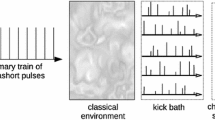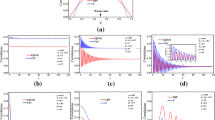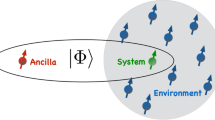Abstract
We investigate the propagation of local bipartite quantum correlations, along with the tripartite mutual information to characterize the information scrambling through dynamical evolution of spin chains. Starting from an initial state with the first pair of spins in a Bell state, we study how quantum correlations spread to other parts of the system, using different representative spin Hamiltonians, viz. the Heisenberg Model, a spin-conserving model, the transverse-field XY model, a non-conserving but integrable model, and the kicked Harper model, a spin conserving but nonintegrable model. We show that the local correlations spread consistently in the case of spin-conserving dynamics in both integrable and nonintegrable cases, with a strictly nonnegative tripartite mutual information. In contrast, in the case of non-conserving dynamics, tripartite mutual information is negative and local pair correlations do not propagate.








Similar content being viewed by others
Data Availability
All data generated or analyzed during this study are available from the authors on reasonable request.
References
Bose, S.: Quantum communication through an unmodulated spin chain. Phys. Rev. Lett. 91, 207901 (2003)
Subrahmanyam, V.: Entanglement dynamics and quantum-state transport in spin chains. Phys. Rev. A 69, 034304 (2004)
Christandl, M., Datta, N., Ekert, A., Landahl, A.J.: Perfect state transfer in quantum spin networks. Phys. Rev. Lett. 92, 187902 (2004)
Wang, Z.-M., Byrd, M., Shao, B., Zou, J.: Quantum communication through anisotropic Heisenberg xy spin chains. Phys. Lett. A 373(6), 636–643 (2009)
Subrahmanyam, V., Lakshminarayan, A.: Transport of entanglement through a Heisenberg-xy spin chain. Phys. Lett. A 349(1), 164–169 (2006)
Sachdev, S.: Quantum Phase Transitions. Cambridge University Press, Cambridge (1999)
Jordan, P., Wigner, E.: Über das paulische äquivalenzverbot. Z. Phys. 47(9), 631–651 (1928)
Lieb, E., Schultz, T., Mattis, D.: Two soluble models of an antiferromagnetic chain. Ann. Phys. 16(3), 407–466 (1961)
Takahashi, M.: Thermodynamics of One-dimensional Solvable models. Cambridge University Press, Cambridge (2005)
Bethe, H.: Zur Theorie der Metalle. I. Eigenwerte und Eigenfunktionen der Hnearen Atomkette.Zeitschrift für Physik 71(3), 205–226 (1931)
Ganahl, M., Rabel, E., Essler, F.H.L., Evertz, H.G.: Observation of complex bound states in the spin-\(1/2\) Heisenberg \(xxz\) chain using local quantum quenches. Phys. Rev. Lett. 108, 077206 (2012)
Fukuhara, T., Schauß, P., Endres, M., Hild, S., Cheneau, M., Bloch, I., Gross, C.: Microscopic observation of magnon bound states and their dynamics. Nature 502(7469), 76–79 (2013)
Vlijm, R., Ganahl, M., Fioretto, D., Brockmann, M., Haque, M., Evertz, H.G., Caux, J.-S.: Quasi-soliton scattering in quantum spin chains. Phys. Rev. B 92, 214427 (2015)
Steinigeweg, R., Langer, S., Heidrich-Meisner, F., McCulloch, I.P., Brenig, W.: Coherent spin-current oscillations in transverse magnetic fields. Phys. Rev. Lett. 106, 160602 (2011)
Foster, M.S., Berkelbach, T.C., Reichman, D.R., Yuzbashyan, E.A.: Quantum quench spectroscopy of a Luttinger liquid: Ultrarelativistic density wave dynamics due to fractionalization in an \(xxz\) chain. Phys. Rev. B 84, 085146 (2011)
Cazalilla, M.A., Chung, M.-C.: Quantum quenches in the Luttinger model and its close relatives. J. Stat. Mech. Theory Exp. 2016(06), 064004 (2016)
Mukherjee, V., Divakaran, U., Dutta, A., Sen, D.: Quenching dynamics of a quantum \(xy\) spin-\(\frac{1}{2}\) chain in a transverse field. Phys. Rev. B 76, 174303 (2007)
Nag, T., Dutta, A., Patra, A.: Quenching dynamics and quantum information. Int. J. Mod. Phys. B 27, 1345036 (2013)
Manmana, S.R., Wessel, S., Noack, R.M., Muramatsu, A.: Time evolution of correlations in strongly interacting fermions after a quantum quench. Phys. Rev. B 79, 155104 (2009)
Sodano, P., Bayat, A., Bose, S.: Kondo cloud mediated long-range entanglement after local quench in a spin chain. Phys. Rev. B 81, 100412 (2010)
Chiara, G.D., Montangero, S., Calabrese, P., Fazio, R.: Entanglement entropy dynamics of Heisenberg chains. J. Stat. Mech. Theory Exp. 2006(03), P03001–P03001 (2006)
Safavi-Naini, A., Wall, M.L., Acevedo, O.L., Rey, A.M., Nandkishore, R.M.: Quantum dynamics of disordered spin chains with power-law interactions. Phys. Rev. A 99 (2019)
De Roeck, W., Huveneers, F.: Stability and instability towards delocalization in many-body localization systems. Phys. Rev. B 95 (2017)
Hayden, P., Preskill, J.: Black holes as mirrors: quantum information in random subsystems. J. High Energy Phys. 2007(09), 120–120 (2007)
Sekino, Y., Susskind, L.: Fast scramblers. J. High Energy Phys. 2008(10), 065–065 (2008)
Cover, T.M., Thomas, J.A.: Elements of Information Theory. John Wiley & Sons, London (2006)
Iyoda, E., Sagawa, T.: Scrambling of quantum information in quantum many-body systems. Phys. Rev. A 97, 042330 (2018)
Campisi, M., Goold, J.: Thermodynamics of quantum information scrambling. Phys. Rev. E 95, 062127 (2017)
Landsman, K.A., Figgatt, C., Schuster, T., Linke, N.M., Yoshida, B., Yao, N.Y., Monroe, C.: Verified quantum information scrambling. Nature 567(7746), 61–65 (2019)
Seshadri, A., Madhok, V., Lakshminarayan, A.: Tripartite mutual information, entanglement, and scrambling in permutation symmetric systems with an application to quantum chaos. Phys. Rev. E 98, 052205 (2018)
Hosur, P., Qi, X.-L., Roberts, D.A., Yoshida, B.: Chaos in quantum channels. J. High Energy Phys. 2016(2), 4 (2016)
Cerf, N.J., Adami, C.: Information theory of quantum entanglement and measurement. Phys. D Nonlinear Phenom. 120(1), 62–81 (1998). (Proceedings of the Fourth Workshop on Physics and Consumption)
Subrahmanyam, V.: Quantum entanglement in Heisenberg antiferromagnets. Phys. Rev. A 69, 022311 (2004)
Kundu, A., Subrahmanyam, V.: Distribution of quantum correlations and conditional entropy in Heisenberg spin chains. J. Phys. A Math. Theor. 46(43), 435304 (2013)
Wootters, W.K.: Entanglement of formation of an arbitrary state of two qubits. Phys. Rev. Lett. 80, 2245–2248 (1998)
Sur, S., Subrahmanyam, V.: Remotely detecting the signal of a local decohering process in spin chains. J. Phys. A Math. Theor. 50(20), 205303 (2017)
Sur, S., Subrahmanyam, V.: Interference of the signal from a local dynamical process with the quantum state propagation in spin chains. J. Phys. A Math. Theor. 52(1), 015302 (2018)
Izyumov, Y.A., Skryabin, Y.N.: Statistical Mechanics of Magnetically Ordered Systems. Springer, Heidelberg (1988)
Lima, R., Shepelyansky, D.: Fast delocalization in a model of quantum kicked rotator. Phys. Rev. Lett. 67, 1377–1380 (1991)
Lakshminarayan, A., Subrahmanyam, V.: Entanglement sharing in one-particle states. Phys. Rev. A 67, 052304 (2003)
Sur, S., Ghosh, A.: Quantum counterpart of measure synchronization: a study on a pair of harper systems. Phys. Lett. A 384(8), 126176 (2020)
Bogoljubov, N.N.: On a new method in the theory of superconductivity. Nuovo Cimento 7(6), 794 (1958)
Valatin, J.G.: Comments on the theory of superconductivity. Nuovo Cimento 7(6), 843 (1958)
Peskin, M.E., Schroeder, D.V.: An Introduction to Quantum Field Theory. Persesus Books, Massachusetts (1995)
Lindgren, I., Morrison, J.: Atomic Many-Body Theory. Springer, Heidelberg (1982)
Acknowledgements
We acknowledge the support of Department of Physics, Indian Institute of Technology, Kanpur, where part of the work was carried out. VS acknowledges the support of Science and Engineering Research Board, through MATRICS scheme.
Author information
Authors and Affiliations
Corresponding author
Additional information
Publisher's Note
Springer Nature remains neutral with regard to jurisdictional claims in published maps and institutional affiliations.
Appendices
Appendix A: Pairwise correlation functions for the XY model with transverse field
The expectation values of the correlation functions \(\langle c^{\dagger }_jc_j\rangle \), \(\langle c_jc^{\dagger }_{j+1}\rangle \), \(\langle c_jc_{j+1} \rangle \) and \(\langle c^{\dagger }_jc_jc^{\dagger }_{j+1}c_{j+1}\rangle \) as a function of time can be calculated analytically as shown as
Correlation functions between the sites i and \(i+1\) are shown as functions of time t for the transverse field XY model for various Hamiltonian parameters. \(\mathrm{Re} \langle \sigma ^+_i \sigma ^-_{i+1}\rangle _t\) is plotted as a function of time for parameters: a \(J_x =0.7, J_y = 0.3\) and \(h = 0.1\), b \(J_x =0.7, J_y = 0.3\) and \(h = 1.0\), c \(J_x =0.7, J_y = 0.3\) and \(h = 10.0\). \(\mathrm{Re} \langle \sigma ^+_i \sigma ^+_{i+1}\rangle _t\) is plotted as a function of time for parameters: d \(J_x =0.7, J_y = 0.3\) and \(h = 0.1\), e \(J_x =0.7, J_y = 0.3\) and \(h = 1.0\), f \(J_x =0.7, J_y = 0.3\) and \(h = 10.0\). \(\langle \sigma ^z_i \sigma ^z_{i+1}\rangle _t\) for parameters: g \(J_x =0.7, J_y = 0.3\) and \(h = 0.1\), h \(J_x =0.7, J_y = 0.3\) and \(h = 1.0\), i \(J_x =0.7, J_y = 0.3\) and \(h = 10.0\). The results are shown from analytical calculations for the initial state: \(\vert \Psi (0)\rangle = (\vert 10\ldots 0\rangle +\vert 010\ldots 0\rangle )/\sqrt{2}\)
We see from the above set of equations that the time evolution mixes different operators. Any product of fermion operators in the real space involves N sums over momenta values in real space. The expectation values of products of fermionic operators can be straightforwardly evaluated using Wick’s theorem [44, 45]. However, there will be N sums over the momentum variables. For a large value of N, the above sums are evaluated by converting them to integrals from 0 to \(\pi \). The pairwise correlation functions between the nearest neighbors are plotted as functions of site index i and time t in Fig. 9. We have taken three sets of Hamiltonian parameters \((J_x = 0.7, J_y = 0.3, h = 0.1)\); \((J_x = 0.7, J_y = 0.3, h = 1.0)\) and \((J_x = 0.7, J_y = 0.3, h = 10.0)\) to illustrate the results. The total number of down (up) spins in the system is not conserved as \(J_x \ne J_y\). However, in the limit \(h \rightarrow \infty \), the dynamics is confined to a subspace of the total Hilbert space, as the Hamiltonian in this case commutes with the total number of down (up) spins. The initial state being \(\vert \Psi \rangle = \frac{1}{\sqrt{2}}(100...0 + 010...0)\), the initial values of the off-diagonal correlation function \(\langle \sigma ^+_i \sigma ^-_{i+1}\rangle \) is 0.5 the diagonal correlation function \(\langle \sigma ^z_i \sigma ^z_{i+1}\rangle \) is \(-1\) for the first pair and zero for all other pairs.
As time evolves, the correlation function \(\langle \sigma ^+_i \sigma ^-_{i+1}\rangle \) becomes nonzero for farther sites for later times implying a finite speed of propagation of correlations) for the case \(h = 0.1\) as shown in Fig. 9a. The value of the function \(\langle \sigma ^+_i \sigma ^-_{i+1} \rangle \) is nonzero within the ‘light cone’ but zero outside. For the case \(h = 1.0\), the correlation function \(\langle \sigma ^+_i \sigma ^-_{i+1} \rangle \) decays very quickly and becomes zero beyond the third site as shown in Fig. 9b. For the case \(h = 10.0\), the correlations propagate consistently and continuously to further sites with a finite speed as shown in Fig. 9c. The diagonal correlation function \(\langle \sigma ^z_i \sigma ^z_{i+1} \rangle \) becomes nonzero for farther sites quickly and propagation does not take place with a finite speed for the cases \(h = 0.1\) and \(h = 1.0\) as shown in Fig. 9d, e, respectively. For the case \(h = 10.0\), the value of the function \(\langle \sigma ^z_i \sigma ^z_{i+1} \rangle \) spreads with finite speed and its value is zero outside the light cone as shown in Fig. 9f. The correlation function \(\langle \sigma ^+_i \sigma ^+_{i+1} \rangle \) is plotted as a function of time and site index for the same set of Hamiltonian parameters in Fig. 9g–i, respectively. The expectation value of the correlation function \(\langle \sigma ^+_i \sigma ^+_{i+1} \rangle \) is initially zero and becomes nonzero as the number of down spins increases in the system. The values of \(\langle \sigma ^+_i \sigma ^+_{i+1} \rangle \) for the case \(h = 10.0\) in Fig. 9i is much smaller compared to the cases \(h = 0.1\) and \(h = 1.0\) as shown in Fig. 9g, h, respectively. This indicates that for a high value of h, less number of down spins is generated in the system as time evolves and the dynamics remains confined mainly in the one spin sector.
Appendix B: Pairwise correlation functions for the Ising model
For the Ising model, the time evolved expectation value of any operator O is given as
The forms of \(\langle \sigma ^z_j \rangle _t, \langle \sigma ^\pm _j\rangle _t, \langle \sigma ^z_j \sigma ^z_{j+1}\rangle _t \) and \(\langle \sigma ^+_j \sigma ^\mp _{j+1}\rangle _t\) can be given by the following
with \(C \equiv \cos (Jt)\) and \(S \equiv \sin (Jt)\).
Rights and permissions
Springer Nature or its licensor holds exclusive rights to this article under a publishing agreement with the author(s) or other rightsholder(s); author self-archiving of the accepted manuscript version of this article is solely governed by the terms of such publishing agreement and applicable law.
Springer Nature or its licensor holds exclusive rights to this article under a publishing agreement with the author(s) or other rightsholder(s); author self-archiving of the accepted manuscript version of this article is solely governed by the terms of such publishing agreement and applicable law.
About this article
Cite this article
Sur, S., Subrahmanyam, V. Information scrambling and redistribution of quantum correlations through dynamical evolution in spin chains. Quantum Inf Process 21, 301 (2022). https://doi.org/10.1007/s11128-022-03641-3
Received:
Accepted:
Published:
DOI: https://doi.org/10.1007/s11128-022-03641-3





